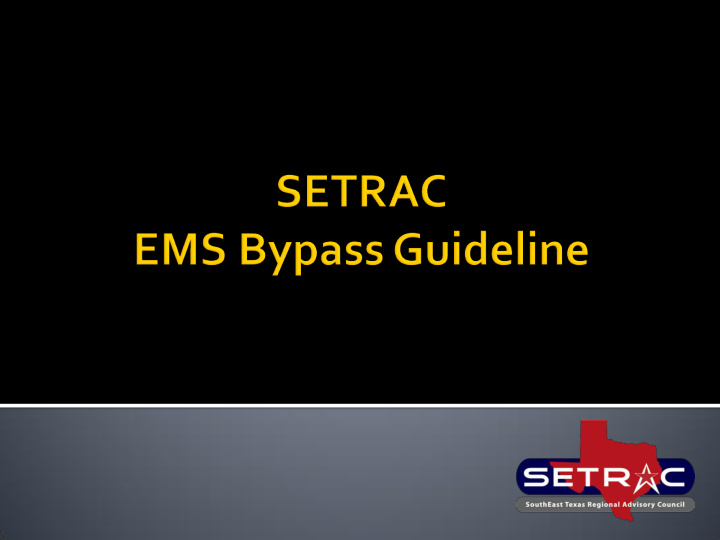



Department of State Health Services (DSHS) rule under Emergency Medical Care in the Texas Administrative Code. Stakeholder request With introduction of CSC, guidance for EMS agencies on bypass criteria was requested. Supports National Guidelines (AHA/ASA)
Stroke Systems of Care Initiative In consultation with the DSHS Office of EMS and in collaboration with the AHA and ASA is developing Stroke System of Care. ▪ Four components of the systems are addressed by the initiative ▪ Development of Stroke Committee in RAC ▪ Development of Stroke Transport Protocols ▪ Emergency Medical Services Training ▪ Development of Stroke Centers Within Hospitals
Stroke Transport Protocols Instruct paramedics to take patients to the highest 3. level state designated Stroke Center if available within the region. In making this determination, distance and time parameters should be considered. There should be no more than a 15 minute delay caused by taking a patient to the next highest level of stroke care. Where the available stroke care level and Stroke Centers are comparable, a scheme should be developed to ensure a fair distribution of patients among qualified Stroke Centers/Facilities except for patient preference.
Title 25 Part 1 ▪ Chapter 157 ▪ Subchapter G Rule 157.133 Requirements for Stroke Facility Designation
(s) A RAC should develop a stroke system plan based on standard guidelines for comprehensive system development. The stroke system plan is subject to review and approval by the department. (3) the following components have been addressed: ▪ (E) pre-hospital triage criteria; ▪ (F) diversion policies; ▪ (G) bypass protocols — guidelines for emergency transport of patients, who are eligible within the timeframe for US FDA approved stroke care therapies, to the highest designated stroke center;
(I) regional stroke treatment guidelines: (i) guidelines consistent with current standards shall be developed, implemented and evaluated; (ii) individual agencies and medical directors may, and are encouraged, to exceed the minimum standards;
Los Angeles Pre hospital Stroke Screen (LAPSS) Rapid identification of stroke Simple Cincinnati Stroke Scale Presence of stroke Simple Miami Dade FD Identification and severity comprehensive
Physician input/consensus Stroke Program Medical Director and EMS Medical Director Meetings met jointly ▪ May 2 ▪ Feedback via email ▪ June 27 ▪ Feedback via email Purpose – produce a pre hospital stroke tool for EMS ▪ Identification of Stroke ▪ Severity indicators ▪ Address CSC and PSC triage
• Produced a guideline that addressed time • and severity • Resolution was passed at the SETRAC October Board Meeting
The board agreed to delay adoption for six months in order for certain actions to be taken in advance of implementation Provide EMS education Develop a data registry to support the intent of this resolution (AHA “Get With The Guidelines”) Propose patient transfer policies that enable prompt transfer Create an IAP model Reassess the Guideline and the Assessment tool in 2014 and periodically thereafter.
This is a Regional Guideline Final authority for patient destination is based on individual agency EMS medical direction. Always follow your agency protocol for patient treatment and consider your proximity to the closest Designated Stroke Center.
Recommend
More recommend